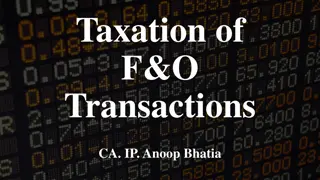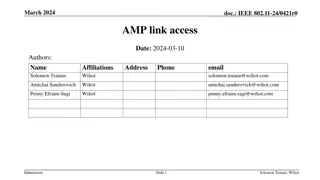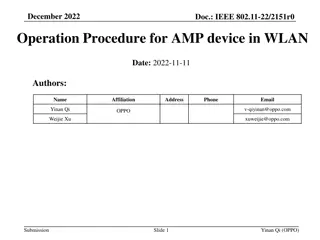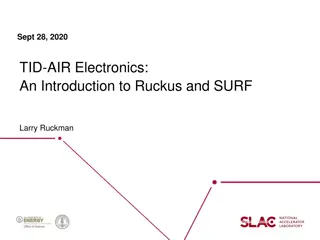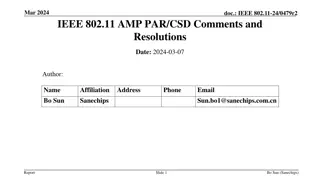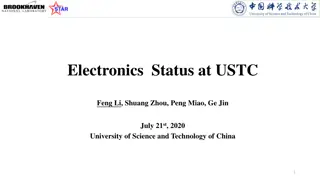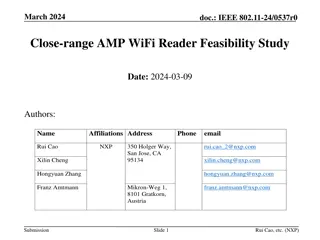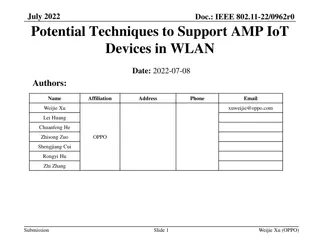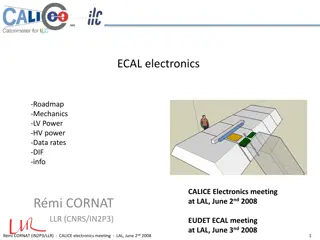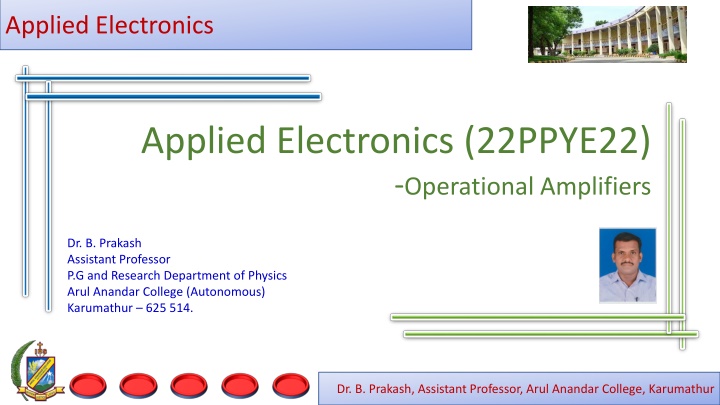
Operational Amplifiers in Electronics
Explore the world of operational amplifiers (op-amps) in electronics, their high gain capabilities, mathematical operations, various types, and applications. Learn about popular op-amp models and their uses in different circuits and systems.
Download Presentation

Please find below an Image/Link to download the presentation.
The content on the website is provided AS IS for your information and personal use only. It may not be sold, licensed, or shared on other websites without obtaining consent from the author. If you encounter any issues during the download, it is possible that the publisher has removed the file from their server.
You are allowed to download the files provided on this website for personal or commercial use, subject to the condition that they are used lawfully. All files are the property of their respective owners.
The content on the website is provided AS IS for your information and personal use only. It may not be sold, licensed, or shared on other websites without obtaining consent from the author.
E N D
Presentation Transcript
Applied Electronics Applied Electronics (22PPYE22) -Operational Amplifiers Dr. B. Prakash Assistant Professor P.G and Research Department of Physics Arul Anandar College (Autonomous) Karumathur 625 514. Dr. B. Prakash, Assistant Professor, Arul Anandar College, Karumathur
OPERATIONAL AMPLIFIER - Introduction An Operational Amplifier, or op-amp for short, is fundamentally a voltage amplifying device High gain and high input resistance Rin Directly coupled negative feedback amplifier the amplifier can perform a variety of mathematical operations like addition, subtraction, multiplication, differentiation and integration etc., in analog computers. That s why it is named as Operational Amplifier . Scale changing, analog computers operations, instrumentation and control systems, phase shift and oscillator circuits. feedback components determine the resulting function or operation of the amplifier by virtue of the different feedback configurations of resistive, capacitive or both, 3
Examples of Op-Amps A709 Semicondutors Ltd., Pune: High gain opamp constructed on a single chip Mainly used for dc servo systems, high impedance analog computers & low level instrumentaion applications. LM 108-LM208 Semiconductors Ltd., Mumbai CA 741 CT- CA 741 T- Bharat Electronics Ltd(BEL), Bangalore: High gain opamps Mainly used for Comparator Integrator Differentiator Summer Dc amplifier Multivibrator Bandpass filter 6
Op-Amp: Symbol & Pin configurations Op-amps (amplifiers/buffers in general) are drawn as a triangle in a circuit schematic There are two inputs inverting and non-inverting And one output Also power connections (note no explicit ground) V+ divot on pin-1 end 7 2 inverting input 6 output + non-inverting input 3 4 V 8
IC 741 Op-Amp basically a three-terminal device consists of two high impedance inputs. One of the inputs: Inverting Input, marked with a negative or minus sign, ( ). The other input: Non-inverting Input, marked with a positive or plus sign ( + ). IC 741 was the first Op-Amp designed and manufactured by Fairchild Semiconductors in 1963. IC741 means 7 functional pins, 4 input pins and 1 output pin. IC741 consists of 20 transistors and 11 resistors in a single monolithic chip. 9
The ideal op-amp Infinite voltage gain (Av = ) a voltage difference at the two inputs is magnified infinitely in truth, something like 200,000 or i.e. 106 means difference between + terminal and terminal is amplified by 200,000! Infinite input Resistance (Rin = ohms) no current flows into inputs in truth, about 1012 for FET input op-amps Ideal Op-Amp is a voltage Controlled device Zero output Resistance (Ro = 0 ohm) rock-solid independent of load roughly true up to current maximum (usually 5 25 mA) Infinitely fast (infinite bandwidth) in truth, limited to few MHz range slew rate limited to 0.5 20 V/ s 14
Op-Amp: Rules When an op-amp is configured in any negative-feedback arrangement, it will obey the following two rules: The inputs to the op-amp draw or source no current (true whether negative feedback or not) The op-amp output will do whatever it can (within its limitations) to make the voltage difference between the two inputs zero 15
Op-amp without feedback The internal op-amp formula is: Vout = gain (V+ V ) So if V+ is greater than V , the output goes positive If V is greater than V+, the output goes negative V Vout + V+ A gain of 200,000 makes this device (as illustrated here) practically useless 16
Infinite Gain in negative feedback Infinite gain would be useless except in the self-regulated negative feedback regime negative feedback seems bad, and positive good but in electronics positive feedback means runaway or oscillation, and negative feedback leads to stability Imagine hooking the output to the inverting terminal: If the output is less than Vin, it shoots positive If the output is greater than Vin, it shoots negative result is that output quickly forces itself to be exactly Vin negative feedback loop + Vin 17
Even under load Even if we load the output (which as pictured wants to drag the output to ground) the op-amp will do everything it can within its current limitations to drive the output until the inverting input reaches Vin negative feedback makes it self-correcting in this case, the op-amp drives (or pulls, if Vin is negative) a current through the load until the output equals Vin so what we have here is a buffer: can apply Vin to a load without burdening the source of Vin with any current! Important note: op-amp output terminal sources/sinks current at will: not like inputs that have no current flow + Vin 18
Positive feedback pathology In the configuration below, if the + input is even a smidge higher than Vin, the output goes way positive This makes the + terminal even more positive than Vin, making the situation worse This system will immediately rail at the supply voltage could rail either direction, depending on initial offset Vin + positive feedback: BAD 19
Virtual Ground & Summing Point Opamp employs ve feedback with the help of resistor Rf Input & feedback currents algebraically added at point A summing point Virtual ground arises from the fact input voltage Vi at the inverting terminal of the Op-amp Point A is essentially ground voltage & referred as Virtual Ground 20
Why Vi is reduced to almost zero? When V1 applied negative feedback produces output voltage V0 which is opposite phase with input The algebraic sum of the two voltages V1 & V0 becomes nearly Vi= 0. This happens only when output V0 is exactly same & opposite equal of V1. If no current flows through the input i=0 means also Vi is nearly zero. 21
Applications of Op-Amp Linear Amplifier Inverting Amplifier or negative Scale Non-Inverting Amplifier or Positive Scaler Unity Follower Adder or Summer Subtractor Integrator Differentiator Comparator 22
Inverting amplifier example R2 R1 Vin Vout + Applying the rules: terminal at virtual ground so current through R1 is If = Vin/R1 Current does not flow into op-amp (one of our rules) so the current through R1 must go through R2 voltage drop across R2 is then IfR2 = Vin (R2/R1) So Vout = 0 Vin (R2/R1) = Vin (R2/R1) Thus we amplify Vin by factor R2/R1 negative sign earns title inverting amplifier Current is drawn into op-amp output terminal 23
Non-inverting Amplifier R2 R1 Vout + Vin Now neg. terminal held at Vin so current through R1 is If = Vin/R1 (to left, into ground) This current cannot come from op-amp input so comes through R2 (delivered from op-amp output) voltage drop across R2 is IfR2 = Vin (R2/R1) so that output is higher than neg. input terminal by Vin (R2/R1) Vout = Vin + Vin (R2/R1) = Vin (1 + R2/R1) thus gain is (1 + R2/R1), and is positive Current is sourced from op-amp output in this example 24
Summing Amplifier Rf R1 V1 R2 Vout + V2 Much like the inverting amplifier, but with two input voltages inverting input still held at virtual ground I1 and I2 are added together to run through Rf so we get the (inverted) sum: Vout = Rf (V1/R1 + V2/R2) if R2 = R1, we get a sum proportional to (V1 + V2) Can have any number of summing inputs we ll make our D/A converter this way 25
Differencing Amplifier R2 R1 V Vout + V+ R1 R2 The non-inverting input is a simple voltage divider: Vnode = V+R2/(R1 + R2) So If = (V Vnode)/R1 Vout = Vnode IfR2 = V+(1 + R2/R1)(R2/(R1 + R2)) V (R2/R1) so Vout = (R2/R1)(V+ V ) therefore we difference V+ and V 26
Differentiator (high-pass) R C Vin Vout + For a capacitor, Q = CV, so Icap = dQ/dt = C dV/dt Thus Vout = IcapR = RC dV/dt So we have a differentiator, or high-pass filter if signal is V0sin t, Vout = V0RC cos t the -dependence means higher frequencies amplified more 27
Low-pass filter (integrator) C R Vin Vout + If = Vin/R, so C dVcap/dt = Vin/R and since left side of capacitor is at virtual ground: dVout/dt = Vin/RC so and therefore we have an integrator (low pass) 28
Thank You! 29

